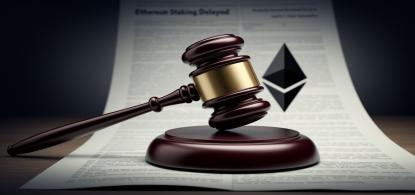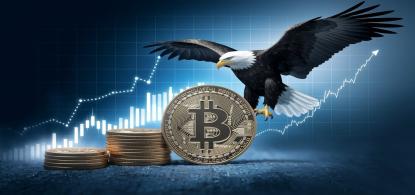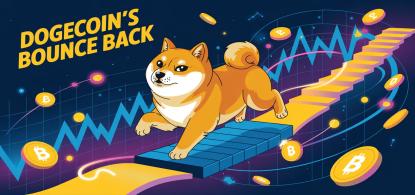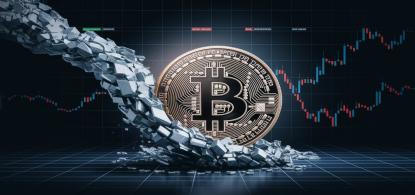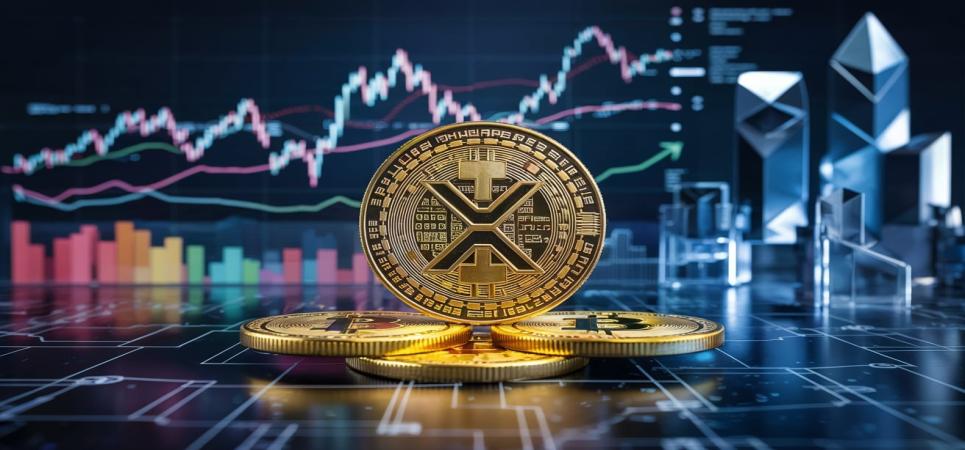
XRP Price Sees 12% Gains as China Tariffs Spark Bitcoin Price Rally
XRP Price Sees 12% Gains as China Tariffs Spark Bitcoin Price Rally
Summary
The last 12% price hike of XRP has caught the attention of most investors, especially when the world market is unpredictable. The largest among numerous reasons why there has been a sudden price rise is the rise in tension between the United States and China regarding new tariffs. When such a global phenomenon happens, conventional markets usually become volatile. Therefore, people start looking for alternative or safer ways of investing their money—cryptocurrencies come in here.
The most popular cryptocurrency, Bitcoin, is usually considered to be a "haven" asset during such difficult times. When Bitcoin's price rises, other currencies like XRP follow. XRP has advantages of its own, however. It is used by banks and financial institutions to make transfers quickly and at low costs across borders. This practical use makes XRP more valuable than many other digital coins.
Also, institutional investors with massive capital bases are increasingly starting to take an interest in digital currencies like XRP. When they move some of their money from stocks or bonds into crypto, it puts more money and faith into the market. This further drives prices up.
Introduction
In the fast-evolving cryptocurrency world, prices can change dramatically as a reaction to global news and market activities. XRP, a top cryptocurrency, just witnessed a significant jump in its price—it rose by 12% in a short period. This sudden rise in the price of XRP came during a larger-than-life crypto market rally, which was mainly ignited by a sudden increase in the price of Bitcoin. Why did this occur? Headlines regarding new tariffs on Chinese imports by leading economies of the world, especially the United States.
When tensions within the global economy rise, such as through the imposition of tariffs (extra taxes on imports), it makes conventional markets such as stocks and bonds unattractive. Investors then start looking for alternative or safer investments. Cryptocurrencies such as Bitcoin and XRP became increasingly popular at that time. This is why, after the new tariffs on China were announced, the value of Bitcoin went up. And when Bitcoin goes up incredibly, it tends to drag along the prices of other cryptocurrencies like XRP, too.
XRP didn't simply ride the trend this time—it stole the show. While most altcoins (alternative currencies to Bitcoin) saw minimal gains, XRP gained by a whopping 12%. This means that sentiment among investors regarding XRP is positive and that it may be benefiting from both the overall crypto price surge as well as bullishness around its market. Some believe XRP's surge may also have something to do with news regarding its legal battle with the U.S. Securities and Exchange Commission (SEC). If XRP wins or gets favorable outcomes in this case, it can improve its image and lead to even higher prices in the future.
China tariffs also bring another layer of interest to this story. When tensions between trade increase, global economies are hurt. Traditional financial systems are strained, and people worry about inflation, job cuts, or slower economic growth. In such a situation, decentralized stores of value like Bitcoin and XRP are desirable since they cannot be controlled by any single government or central authority. They are a standalone means of value, like digital gold. For this reason, they are strengthened in turbulent periods, which is exactly what we are seeing right now.
Table of Contents:
-
What caused XRP to surge by 12% in such a short time?
-
Are rising tensions over China tariffs contributing to investor interest in cryptocurrencies?
-
Is Bitcoin acting as a haven asset during global economic uncertainty?
-
How closely is XRP's price movement linked to Bitcoin’s market performance?
-
Could the recent U.S.-China tariff news have triggered panic buying in crypto markets?
-
Are institutional investors shifting funds from traditional markets to digital assets like XRP?
-
How are global financial markets reacting to the ongoing trade war developments?
-
Is XRP benefitting from increased crypto adoption amid traditional market volatility?
-
Conclusion
-
Frequently Asked Questions (FAQ's)
What caused XRP to surge by 12% in such a short time?
XRP jumped 12% in a matter of minutes, primarily due to two large reasons. One, there was international news regarding new tariffs (additional taxes) on Chinese products, which sent many investors into a panic about the economy. When this occurs, individuals tend to shift their funds from traditional markets into safer or alternative vehicles, such as cryptocurrencies. The price of Bitcoin increased due to this, and when Bitcoin goes up, other coins such as XRP tend to follow.
Second, XRP can have gotten additional publicity from positive news or expectations regarding its lawsuit with the United States Securities and Exchange Commission (SEC). If the situation is favorable to XRP, investors will feel more at ease. So, the amalgamation of international economic concerns, Bitcoin's run-up, and XRP's favorable news propelled its price upward rapidly by 12%.
Are rising tensions over China tariffs contributing to investor interest in cryptocurrencies?
Yes, tensions rising about China tariffs are leading more investors to become interested in cryptocurrencies. When large nations like the U.S. impose additional taxes (tariffs) on Chinese products, it breeds fear and uncertainty in the world's economy. Folks are afraid of increased prices, slowing down business, or even loss of jobs.
During these moments, investors seek safer or alternative destinations for their money—and cryptocurrencies such as Bitcoin and XRP are sought after. These virtual coins are not managed by any single government, hence many view them as a means to safeguard their money during economic hardship. That is why the prices of crypto tend to rise whenever tensions in trade heighten.
Is Bitcoin acting as a haven asset during global economic uncertainty?
Indeed, Bitcoin is beginning to behave as a haven asset amidst international economic instability. A haven asset is an item individuals place their faith in to secure their funds when the economy is unsteady. Like gold, today, Bitcoin is perceived by most investors as a sanctuary to park value when there's chaos in the world—such as inflation increasing, trade wars, or crashing financial markets.
Since Bitcoin is not governed by any government and is in limited supply, individuals think it can secure their money. That is why, when there are worldwide issues such as China tariffs or economic downturns, more individuals buy Bitcoin, driving its price up.
How closely is XRP's price movement linked to Bitcoin’s market performance?
The price action of XRP is largely dictated by the market performance of Bitcoin. In the world of cryptocurrency, Bitcoin rules supreme. If the price of Bitcoin is on the rise, it usually carries other coins like XRP with it. The reason is that the majority of investors ride the wave of Bitcoin and feel more secure investing in other coins when Bitcoin is performing well.
So, if Bitcoin goes up, XRP typically goes up too. But XRP also moves on its own due to its own news, such as developments in its legal case or updates to its payment app. But generally, XRP's price still has a lot to do with what is going on with Bitcoin.
Could the recent U.S.-China tariff news have triggered panic buying in crypto markets?
Yes, recent tariff news between the U.S. and China may have sparked panic buying among crypto markets. When this type of big economic news comes along—like fresh tariffs between two major countries—it creates fear and uncertainty in mainline markets like stocks and bonds. Investors became afraid that the world economy might slow down or become unstable.
At such times, most people scramble their money into cryptocurrencies like Bitcoin, XRP, and others, hoping to save their investments. This is called "panic buying." It happens very fast and causes crypto prices to increase very fast within a short period. Therefore, the news of tariffs might have panicked people and led them to buy more crypto, which resulted in the boom in the market.
Are institutional investors shifting funds from traditional markets to digital assets like XRP?
Indeed, there are indications that institutional investors are now beginning to move some of their funds out of conventional markets and into digital currencies such as XRP. When the stock market loses stability through global challenges—such as the U.S.-China trade war tensions—the large investors seek alternatives where they can safeguard or increase their money.
Cryptocurrencies like popular ones in the market today, including Bitcoin and XRP, are increasingly gaining the interest of such investors as they offer new growth opportunities and are not directly linked to the world economy or central banks. XRP is also supported because it has usage in fast and cheap cross-border payments, generating value independent of mere trading. Therefore, while this shift is yet to continue growing, it's clear that digital assets like XRP are gaining more institutional investors during uncertain times.
How are global financial markets reacting to the ongoing trade war developments?
With rising volatility and significant losses on important indexes, the growing trade tensions between the United States and China have significantly affected world financial markets.
Stock Market Restraints
Stock markets all around saw sharp declines following the United States' declaration of additional tariffs on most countries, including a 34% duty on imports from China, and China's retaliatory attack. On April 4, 2025, the FTSE 100 posted its largest one-day decline since the pandemic caused by COVID-19 pandemic by losing 4.95%. European markets did not remain unaffected either, as Germany's DAX fell by 5%, France's CAC by 4.3%, and Italy's FTSE MIB by nearly 6.5%. The S&P 500 and Nasdaq plummeted more than 4.5% and nearly 6% in America.
Investor Sentiment and Volatility
Investor sentiment has deteriorated considerably following these events. The CBOE Volatility Index, or Wall Street's "fear gauge," rose more than 40, its highest level in eight months, indicating unprecedented market fear. Surveys indicate roughly 61.9% of investors are bearish on the condition of the market in the next six months, roughly twice the normal rate.
Recession Fears and Economic Outlook
The mounting trade war deepened the worries of the chances of a global recession. JPMorgan improved its forecast of a U.S. recession at the end of 2025 from 40% to 60% according to the material impact of the new tariffs on consumers and companies. Similarly, Goldman Sachs improved its forecast of recession likelihood to 35%. Experts estimate that these tariffs would reduce global GDP by 0.5 percentage points, with the effect more concentrated on the U.S. and China.
Mergers and Acquisitions (M&A) Activity
The uncertainty resulting from the tariff chaos has also led to a suspension in global mergers and acquisitions. Swedish fintech firm Klarna and American company Chime are some firms that have postponed listing, with others delaying presentations to investors for fear of uncertainty in the markets. This slowing down in deal-making activity is an echo of the overall hesitation on the part of corporate bosses to undertake significant financial expenditures under unstable economic conditions.
Flight to Safe Haven Instruments
In reaction to uncertainty in the market, investors have resorted to safe-haven instruments such as government bonds, pushing yields lower. The yield on the 10-year U.S. Treasury fell below 4%, signaling expectations of impending economic recessions and increasing inflation. This flight to safety indicates the prevailing uncertainty and fear of risk in the financial market today.
Is XRP benefitting from increased crypto adoption amid traditional market volatility?
Yes, XRP is certainly profiting from the growth of crypto adoption, particularly in times of crypto volatility in conventional markets. If world financial markets are volatile, for instance, due to a trade war or a recession, the majority of investors begin to search for alternate assets. Assets like XRP are more attractive as they're not directly influenced by stock exchanges or government initiatives.
XRP also has a unique benefit. It's not just a standard crypto coin; it's also used by banks for instant and low-cost cross-border money transfers. So, as more people and businesses start to utilize crypto, XRP gets recognized both as an investment and as a valuable utility. This higher usage, coupled with fear in the mainstream markets, helps drive up XRP's value.
Conclusion
Over the last few years, the world has been witnessing rising uncertainty in the financial markets, mainly due to rising tensions between China and the United States regarding trade tariffs. These issues at the global economic level are encouraging investors to find better and more secure ways to protect their funds. Accordingly, the market for cryptocurrency, at the helm of Bitcoin, has seen increased demand. Such coins as XRP have begun to pick up added interest and value as individuals search for something outside the typical stock and bond venues.
XRP, for example, is presently one of the top digital currencies that investors are watching. It recently experienced a sudden 12% price hike, meaning investor demand is increasing rapidly. The price increase is probably due to Bitcoin's stellar performance, panic in global stock markets, and growing perception that cryptocurrencies are a "haven" during an economic downturn.
Another key factor contributing to the popularity of XRP is its use. Most other cryptocurrencies are only for trading or investment, but XRP is also being used by banks and financial institutions for cross-border payments. The use in real life gives XRP more strength and value, especially since digital payment systems keep becoming more popular around the world.
Frequently Asked Questions (FAQ's)
Que: What was the reason for the 12% rise in the price of XRP recently?
Ans: XRP's 12% price hike is primarily due to rising investor appetite in the backdrop of global economic tensions, specifically the recent U.S.-China tariffs. Investors moved most money to cryptos, and a strong buying spree ensued.
Que: How are China tariffs related to the prices of cryptocurrencies?
Ans: China tariffs make the world's financial markets fearful and uncertain. When traditional markets fall, most investors put their money in crypto as a safer or alternative choice, which tends to push crypto prices up.
Que: Is Bitcoin acting as a "haven" asset these days?
Ans: Yes. Like gold, many people are now using Bitcoin as a refuge to store wealth during the economic crisis. Its freedom and rarity appeal to it during uncertain times.
Que: Does XRP always follow the price action of Bitcoin?
Ans: Primarily, yes. XRP will often increase or decrease depending on Bitcoin's moves. XRP may also move in response to news about Ripple, for example, legal developments or payment agreements.
Que: What is "panic buying" in the crypto market?
Ans: Panic buying is when investors make a dash for buying crypto due to fear of missing out or fear of economic events. It has the tendency to lead to sudden price increases, like the recent XRP price surge.
